

Vol. 38 (Nº 48) Year 2017. Page 35
Sergei SCHITOV 1; Pavel TIKHONCHUK 2; Ivan BUMBAR 3; Vyacheslav EVDOKIMOV 4; Evgeniy KUZNETSOV 5; Elena POLIKUTINA 6
Received: 30/09/2017 • Approved: 05/10/2017
ABSTRACT: We present the design and testing results for trailing weight regulator of a wheeled tractor. Implementation of this device for distribution of the trailing weight for tractor's wheels is especially important due to the soil and climatic conditions of the Amur Region - the permafrost. The permafrost imposes some pecularities on agricultural machinery, our proposal successfully solves the mentioned problems. It is found that trailing weight distribution improves performance, tractor traction power, and reduces energy consumption during agricultural work. |
RESUMEN: Presentamos los resultados del diseño y de la prueba para el regulador del peso que se arrastra de un tractor rodado. La aplicación de este dispositivo para la distribución del peso que se arrastra para las ruedas del tractor es especialmente importante debido a las condiciones del suelo y climáticas de la región de Amur-el permafrost. El permafrost impone algunos peculiaridades sobre la maquinaria agrícola, nuestra propuesta resuelve con éxito los problemas mencionados. Se encuentra que la distribución del peso que se arrastra mejora funcionamiento, energía de tracción del tractor, y reduce el consumo de energía durante trabajo agrícola. |
It’s common knowledge that the traction and coupling properties of the mobile energy devices depend on the physical properties of the soil, design parameters of the tractor, its wheel formula, the size of the propulsors, air pressure in the tires, operating speed, trailing weight and other factors (Bekker, 1973; Selivanov, 2016). One of the main ways of increasing the trailing weight is to increase the weight of the energy device itself. Due to the specific conditions of the Amur Region, this approach is unacceptable. One of the peculiarities of the agricultural production in this region is that the spring field works begin when the soil thaws to a depth of 0.06-0.08m. The presence of a solid underlying layer in the form of permafrost and the heavy precipitation typical of this period drastically reduce the load-bearing capacity of soils (Kuznetsov, 2013; Shchitov, Krivuca, 2014). The increase in the tractor's weight under these conditions results in breaking of the upper layer of the soil down to permafrost, degradation of traction and coupling properties and slippage, which, in turn, causes the increase in the man-made (technogenic) impact, and bad flotation even with small hook loads (Behnassi, et al., 2014; Bulinski, 2007; Belyaev, 2004; Zakharov, 1996).
This issue has been studied by a large number of scientists around the world who offered various ways to solve it. For instance, the cited research (Vorokhobin, et al., 2016) explores the balance between the load-carrying capacity and the speed of movement of the transport aggregate. The optimal ratio of these two factors helps to reduce the vertical load on the soil. The sustainable dead weight loading is also an efficient way to reduce the impact of the ground drive system on the soil when the tractor is in motion (Selivanov, Makeeva, 2015). However, the dead weight loading increases metal consumption, fuel consumption and cost of the tractor.
The conducted out analysis of foreign and domestic scientific works shows that the known methods for the improvement of traction and coupling properties of the wheeled tractor (Milan, 2014; Selivanov, Makeeva, 2015; Selivanov, 2016) are not efficient when one needs to reduce the man-made (technogenic) impact of the ground drive system on the soil and simultaneously achieve sufficient traction properties of the machine-tractor units (MTA) or tractor-transport units (TTA).
Consequently, the goal of the research is the determination of new methods for the improvement of traction and coupling properties and reduction of the man-made (technogenic) impact on the cultivated soil applied by the ground drive system of a wheeled tractor in motion, which are important components for increasing the productivity and efficiency of manpower and mechanized work, as well as rational use of natural resources and long-term conservation of soil horizons (Brouwer, et al. (eds.), 2010; Lichtfouse (ed.), 2015; Maharjan, et al., 2013; Mendes, et al. (eds.), 2013).
The previous research (Kuznetsov, et al., 2016; Skuryatin, et al., 2014; Skuryatin, et al., 2014; Schitov, 2015) established that the optimal means to achieve this goal is the rational distribution of the coupling weight attributable to the tractor's propulsors. For the non-wheel-drive modifications, the redistribution of the weight from the non-driving front wheels to the rear driving wheels is used, with the preloading of the front wheels to ensure longitudinal stability when necessary.
An example of optimal combining of a tractor with a trailing weight distribution device is presented in the Russian patent no 164794. Figures 1 and 2 show a sketch of a wheeled tractor with a trailing weight distribution device and its general view (Kuznetsov, Schitov, 2015).
The special characteristic of the device lies in its ability to partially redistribute the proper load (trailing weight) of the tractor between the rear driving axle and the front non-driving steering axle.
The underlying idea of the invention is as follows: in case of sufficient traction and coupling the tractor operates as a stock modification, and in case of insufficient traction and coupling part of the tractor's weight is distributed from the non-driving wheels to the driving wheels. Furthermore, during the service movement, when the assembled agricultural machine is in the transportation mode, the device makes it possible to transfer a part of the weight from the rear driving wheels to the front non-driving wheels to increase the longitudinal stability, which significantly reduces the probability of the overturning.
Fig. 1. A wheeled tractor with a trailing weight distribution device
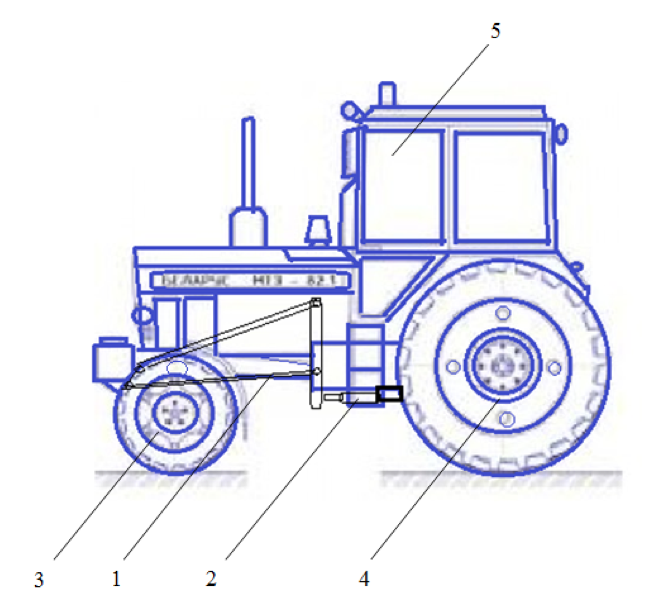
1 - traction and loading device; 2 - hydraulic power cylinder;
3 - front non-driving wheels; 4 - rear driving wheels; 5 - tractor.
-----
Fig. 2. General view of the tractor with a trailing weight distribution device.
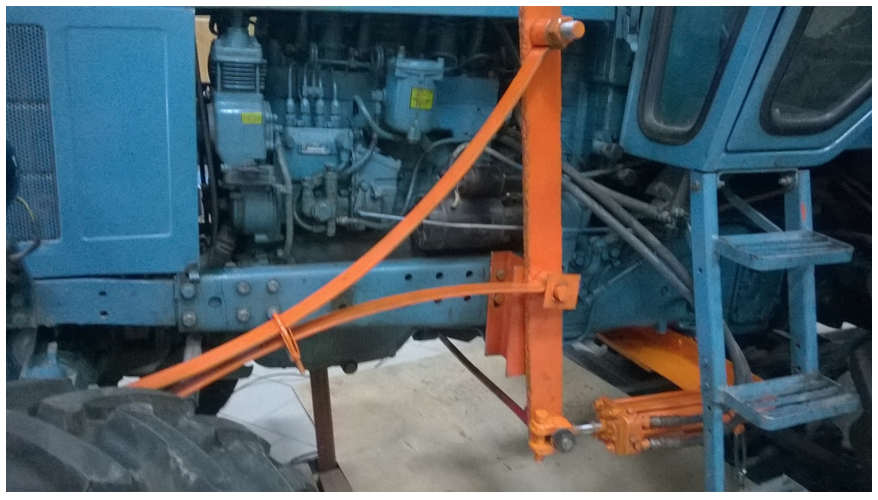
The testing of the experimental aggregate equipped with the proposed device was carried out in accordance with the recommended general and particular methods using specialized programs for mathematical calculation, experimental simulation and regression analysis methods. The following parameters were measured: traction power, rotary velocity of the driving wheels, trailing weight, distance travelled, testing period. For the determination of the above-mentioned parameters, an on-board measuring system was used. Comparative economic tests were conducted with the implementation of the timekeeping method. The data obtained during the experiment was processed via known methods of mathematical statistics on the computer.
The empirical and experimental studies of the wheeled tractor equipped with a trailing weight distribution device carried out at Far Eastern State Agrarian University (Blagoveschensk, Russian Federatiom) and several agricultural enterprises confirmed the validity and correctness of the systemic algorithm for selecting trailing weight distribution devices (Kuznetsov, et al., 2016) and the need for their application in crop production technology.
The study (Schitov, et al., 2015) provides theoretical justification of the redistribution of the trailing weight from the rear driving wheels of the tractor to the front non-driving wheels. This is related to the fact that in recent years the weight of agricultural machines has increased due to the combination of a number of operations performed and several agricultural units. As a result, during technological moves or using an agricultural machine in a transportation mode the longitudinal stability of the tractor is significantly reduced. The conducted experimental research (Fig. 3) established that the longitudinal stability of the tractor may be ensured by the additional loading of the front steering axle, and consequently, that of the front non-driving wheels of the tractor. At this, the amount of additional load and the point of its application both affect the amount of unloading of the rear driving wheels and the additional load of the front wheels.
Fig. 3. Fragment of experimental research.
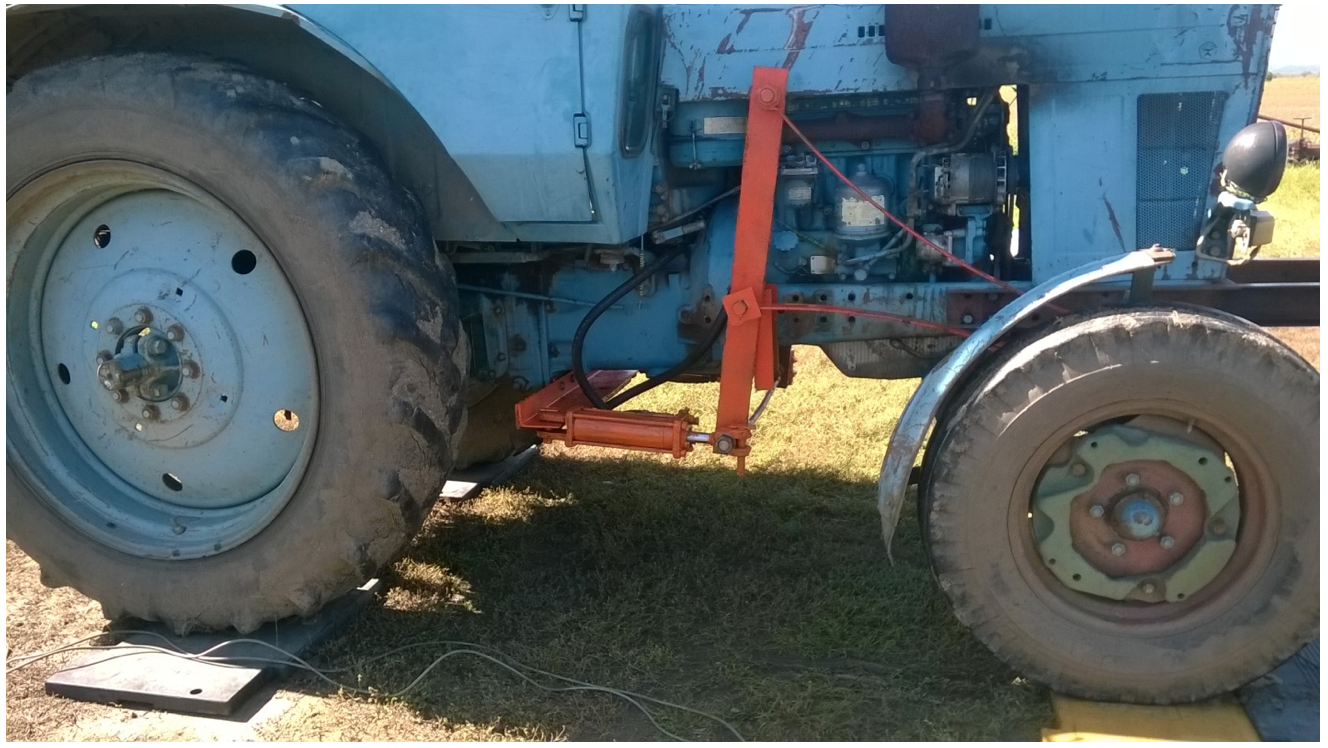
The proposed determinative factor analysis models, obtained as a result of mathematical studies using the polypominal equations, show the dependencies between the unloading of the rear driving axle Y'B, the force applied to the device PB, the displacement of its application point a'y, (Fig. 4), as well as the dependencies between the additional loading of the front steering axle and the non-driving wheels Y'п, the force applied to the device P'Band the displacement of its application point a'y, (Fig. 5).
------
Fig. 4. The effect of the force applied to the device and its point of
application on the unloading of the driving wheels of the tractor.
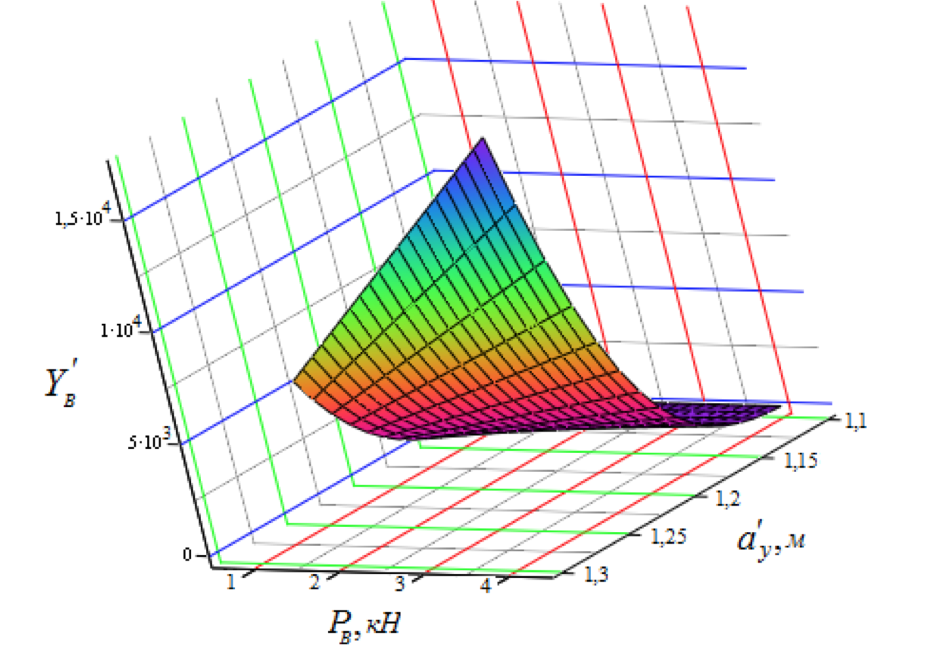
-----
Fig. 5. The effect of the force applied to the device and the point of
application on the additional loading of the front axle of the tractor
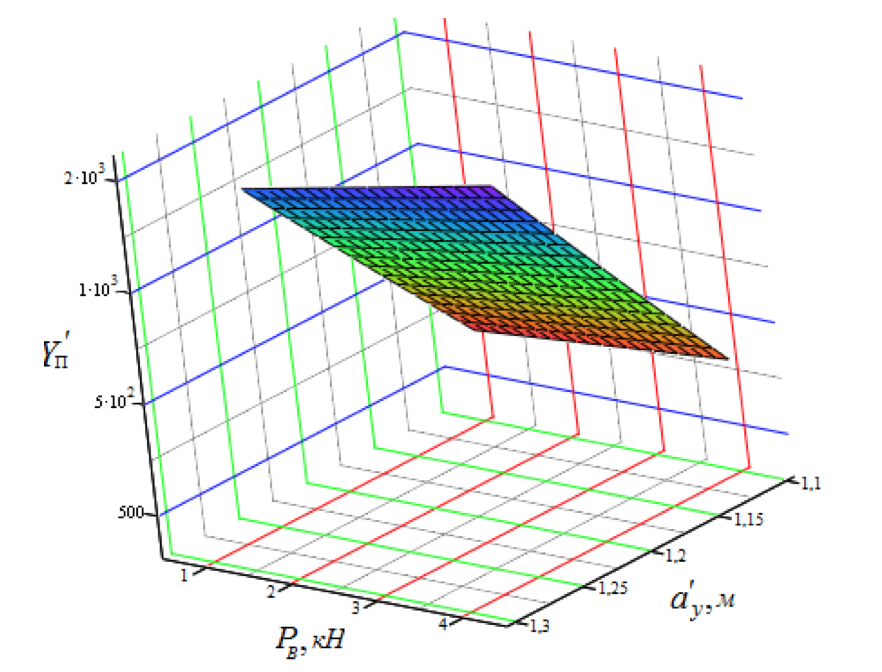
The carried out research shows that the additional loading of the front driving wheels amounts to 60…64% of the maximum applied effort.
Theoretical research showed that the use of the device in question allows to increase the trailing weight of the tractor by partial redistribution of the weight from the front non-driving wheels to the rear driving wheels (Schitov, 2016; Schitov, et al., 2015). The conducted experimental research established that the proposed device is able to increase the trailing weight of the tractor Y''B attributed to the rear driving axle depending on the applied force Pп and the point of its application a''y (Fig. 6). The increase in the trailing weight was 25...30 %, while the slipping of the traction wheels, depending on the hook load, decreased by 15...18% compared to the stock tractor.
Fig. 6. The effect of the applied force and the point of application
on the increase in the trailing weight on the rear drive axle.
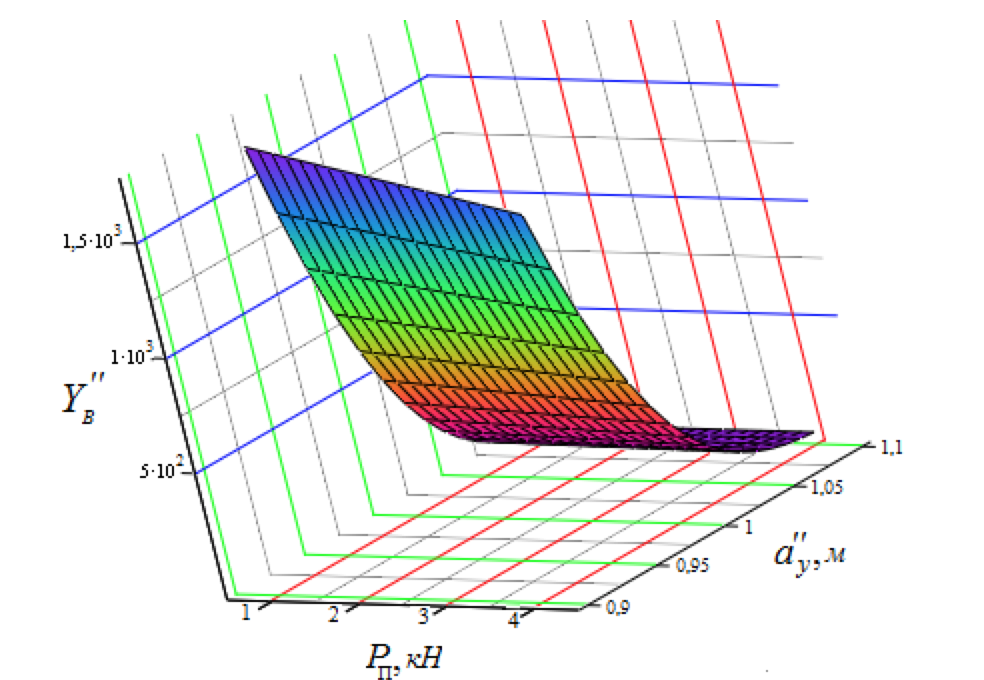
The technical and energy evaluation of use of the experimental tractor equipped with the device for the redistribution of the coupling weight showed that in the course of the main field agricultural works (rolling, continuous cultivation and harrowing) the traction power increased by 20...24%, the speed of movement increased by 18...22%, the performance of the tractor unit improved by 27...29%, while slippage decreased by 28...32%, the specific fuel consumption per 1 hectare decreased by 8...14%, and the total energy consumption per 1 hectare decreased by 13...15% when compared to the stock tractor (Kuznetsov, et al., 2017).
The reliability of the obtained data is confirmed by the convergence of the theoretical justifications and experimental parameters determined in the real operating conditions of the experimental energy device. The comparison of these results with the data previously obtained by the researchers (Belyaev, 2004; Skuryatin, et al., 2013; Skuryatin, Solovyev, 2014; Selivanov, Makeeva, 2015; Vorokhobin, et al., 2016) proves the effectiveness of the proposed solution, which has not been considered by the applied science in its entirety before now.
Based on the above, we conclude that the use of the trailing weight distribution device allows to regulate the trailing weight of the tractor by increasing its traction and coupling properties, as well as reduce the energy costs and man-made (technogenic) impact on soils due to the reduction in slippage. Consequently, the proposed device is a highly efficient design implementing original ideas and a construction novelty intended for rational regulation and redistribution of the coupling weight of a wheeled tractor.
The results of the empirical and practical studies have been approved of and recommended by the expert commission for the introduction of scientific and technical developments and best practices in the agro-industrial production under the Department of Agriculture of the Administration of the Tambovskaya Area of the Amur Region. The materials of the research are implemented in the agricultural production technology used by ZAO "Agrofirm "Partizan", OOO "SOYUZ", OAO "Dimskoye", OOO "Krasnaya Zvezda" and at a number of other agricultural enterprises.
The implementation of the obtained results in the production allowed to improve the flotation of the agricultural unit, reduce the probability of overturning and slippage, increase the safety of operation and the efficiency of wheeled tractors on aggregation, which resulted in slashing the energy costs and increasing the economic effect of its application in agriculture, and long-term conservation of soil horizons, which is especially important for modern natural resource management.
Bekker, M.G. (1973). Introduction to Terrain-Vehicle Systems. Part I. The Terrain. Part II. The Vehicle (520 p.). Ann Arbor: The University of Michigan Press.
Behnassi, M., Syomiti Muteng'e, M., Ramachandran, G., Shelat, K.N. (eds.). (2014). Vulnerability of Agriculture, Water and Fisheries to Climate Change: toward Sustainable Adaptation Strategies (336 p.).
Brouwer, F.M., van Ittersum, M. (eds.). (2010). Environmental and Agricultural Modelling: Integrated Approaches for Policy Impact Assessment (322 p.).
Bulinski, J. (2007). Effect of moisture content in soil on its compaction caused by multipie running of agricultural vehicles. Bulinski, J. Niemczyk, H. (eds.). Annals of Warsaw University of Life Sciences, no. 50, p. 3-8.
Belyaev, V.I. (2004). Ecological Consequences of Conversion of Steppe to arable Land in Western Siberia. Belyaev, V.I., Fruhauf, M., Mainel, T. (eds.). Europa Regional, vol. 1, no. 4, p. 13-21.
Kuznetsov, E.E. (2013). The use of the multi-axis energy devices of class 1.4: monograph. FESAU-Blagoveschensk, (153 p.).
Kuznetsov, E.E., Kuznetsova, O.A., Polikutina, E.S. (2017). Energy consumption dependencies of an experimental machine-tractor aggregate equipped with a trailing weight distribution device. Current Issues in Science and Technology, no. 4, p. 26-29. Collection of studies presented at the international applied research conference, (April 11). Samara.
Kuznetsov, E.E., Schitov, S.V. Hydro-chain regulating device. Utility model patent no. 164794 Russian Federation, applicant and patent holder - Far Eastern State Agrarian University, application no.2015153398 submitted on December 11 (2015), registered on December 11 (2015), published on September 20 (2016). Bulletin, no. 26, p. 10.
Kuznetsov, E.E., Schitov, S.V., Polikutina, E.S. (2016). Methodological validation of the design for rational trailing weight distribution devices. AgroEcoInfo, no. 2. Retrieved from: http://agroecoinfo.narod.rU/iournal/STATYI/2016/2/st 209.doc
Lichtfouse, E. (ed.). (2015). Sustainable Agriculture Reviews, vol. 15, p. 407.
Maharjan, K.L., Joshi, N.P. (2013). Climate Change, Agriculture and Rural Livelihoods in Developing Countries. Series: Advances in Asian Human-Environmental Research, (176 p.).
Mendes, A., L.D.G. Soares da Silva, E., Azevedo, S., Jorge, M. (eds.). (2013). Efficiency Measures in the Agricultural Sector: With Applications, (197 p.).
Milan, J. (2014). Advanced Transport Systems: Analysis, Modeling, and Evaluation of Performances, (408 p.).
Schitov, S.V. (2016). Functional expansion of tractors class 1.4. Far Eastern Agrarian Bulletin, vol. 1, no. 37, p. 67-70.
Schitov, S.V. (2015). The use of a spring-loaded mechanism to increase the load on the front steering axle of a tractor. Academic Review, no. 11, p. 18-23.
Schitov, S.V. (2015). The improvement of traction and coupling properties of a wheeled tractor class 1.4. Academic Review, no. 11, p. 30-34.
Shchitov, S.V., Krivuca, Z.F. (2014). Influence of Ambient Air Temperature on the Efficiency of Vehicles. World Applied Sciences Journal, vol. 30, no. 3, р. 362-365.
Schitov, S.V., Polikutina, E.S., Kuznetsov, Е.Е. (2015). Ways and means of optimization of traction and coupling properties of the energy device. Engineering and equipment for the village, no. 8, p. 26-27.
Selivanov, N.I. (2016). Improvement of classification and use of energy-packed tractors. Krasnoyarsk State Agrarian University Bulletin, vol. 4, no. 115, p. 113-119.
Selivanov, N.I., Makeeva, Yu.N. (2015). Dead weight loading of wheeled tractors during soil cultivation. Krasnoyarsk State Agrarian University Bulletin, no. 5, p. 77-81.
Selivanov, N.I., Makeeva, Yu.N. (2015). Adaptation of wheeled tractors to soil cultivation technologies. Modern Issues in Science and Education, no. 1-1, p. 344.
Skuryatin, N.F., Solovyev, Е.V. (2014). Research in the kinematics of a tractor aggregate travelling on a rough terrain with a traction-loading device. Innovations in the Agroindustrial Complex: Challenges and Opportunities, vol. 3, no. 3, p. 23-28.
Skuryatin, N.F., Solovyev, E.V., Bondarev, А.V. (2014). The increase in the load-carrying capacity of the trailed unit. The Rural Mechanization Expert, no. 12, p. 38-39.
Skuryatin, N.F., Bondarev, A.V., Solovyev, E.V., Amosov, V.N. (2013). Study of forces applied to the traction-loading device. Bulletin of the Voronezh State Agrarian University, no. 4, p. 94-98.
Vorokhobin, A.V., Vysotskaya, Е.А., Skuryatin, N.F. (2016). The reduction in the soil-packing impact caused by ground drive systems of the mobile energy devices. Modern scientific and practical solutions for the 21st century. Materials of the international applied research conference, (p. 15-19). Voronezh.
Zakharov, N.S. (1996). Laws of change of quality of machines during use. Operation efficiency increase of wheel and track machines under severe operating conditions: Proceedings of the international scientific and technical conference, (р. 110-116). Tyumen: Tyumen state oil and gas university.
1. Doctor of Technical Sciences. Department of Transport-Energy Funds and Mechanization of the Agro-Industrial Complex. Far East State Agrarian University. sschitov@yahoo.com
2. Doctor of Agricultural Sciences. Department of General Agriculture and Plant Cultivation. Far Eastern State Agrarian University. tikhonchukp@rambler.ru
3. Doctor of Technical Sciences. Department of Transport-Energy Funds and Mechanization of the Agro-Industrial Complex. Far Eastern State Agrarian University. ji.tor@mail.ru
4. Doctor of Technical Sciences. Department of Transport-Energy Funds and Mechanization of the Agro-Industrial Complex. Far Eastern State Agrarian University. ji.tor@mail.ru
5. Candidate of Technical Sciences. Department of Transportation and Maintenance and Repair of Machines and Technological Complexes. Far Eastern State Agrarian Universityji.tor@mail.ru
6. Postgraduate student. Department of Transport-Energy Funds and Mechanization of the Agro-Industrial Complex. Far Eastern State Agrarian University. ji.tor@mail.ru